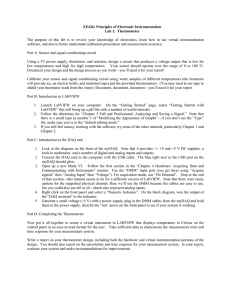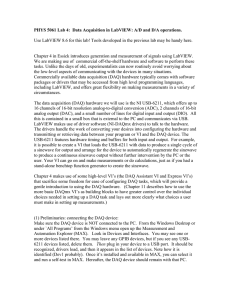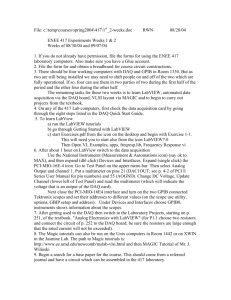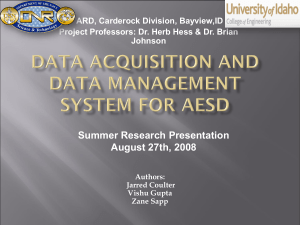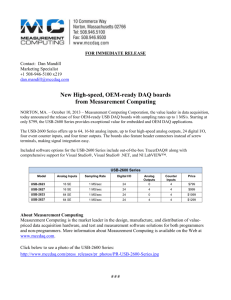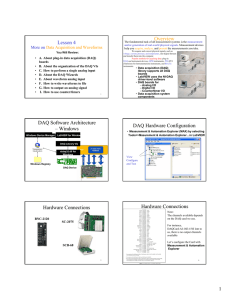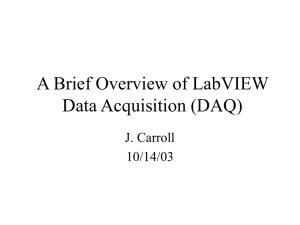Lesson 5 Data Acquisition and Waveforms
advertisement
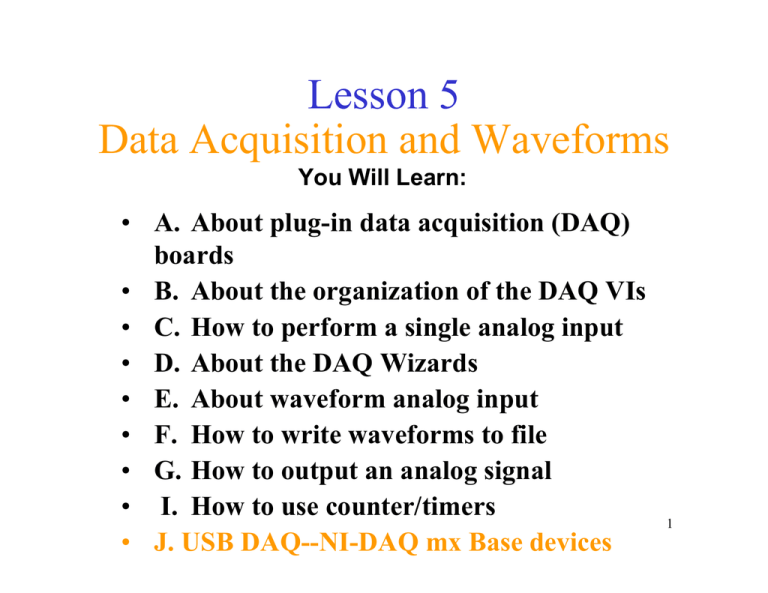
Lesson 5 Data Acquisition and Waveforms You Will Learn: • A. About plug-in data acquisition (DAQ) boards • B. About the organization of the DAQ VIs • C. How to perform a single analog input • D. About the DAQ Wizards • E. About waveform analog input • F. How to write waveforms to file • G. How to output an analog signal • I. How to use counter/timers • J. USB DAQ--NI-DAQ mx Base devices 1 Overview The fundamental task of all measurement systems is the measurement and/or generation of real-world physical signals. Measurement devices help you acquire, analyze, and present the measurements you take. We acquire and convert physical signals, such as voltage, current, pressure, and temperature, into digital formats and transfer them into the computer. Popular methods for acquiring data: plug-in DAQ and instrument devices, GPIB instruments, PXI (PCI eXtensions for Instrumentation) instruments, and RS-232 instruments. • Data acquisition (DAQ) library supports all DAQ boards • LabVIEW uses the NI-DAQ driver-level software • DAQ boards for – Analog I/O – Digital I/O – Counter/timer I/O • Data acquisition system components 2 DAQ Software Architecture – Windows Windows Device Manager LabVIEW for Windows DAQ Library VIs nidaq32.dll for Windows DAQ-STC Windows Registry DAQ Device 3 DAQ Hardware Configuration • Measurement & Automation Explorer (MAX) by selecting Tools>>Masurement & Automation Explorer…in LabVIEW View Configure and Test 4 Hardware Connections BNC-2120 SC-2075 SCB-68 5 Hardware Connections Note: The channels available depends on the DAQ card we use. For instance, DAQCard-AI-16E-4 NI lent to us, there is no output channels available Let’s configure the Card with Measurement & Automation Explorer 6 Measurement Fundamentals In Analytical Instrumentation, we convert physical phenomena into data, using a transducer to convert a physical phenomenon into an electrical signal. Summary of signal sources and masurement systems 7 Measurement Fundamentals There are two types of voltage: direct current (DC) and alternating current(AC). DC signals are analog signals that slowly vary with time. Common DC signals include voltage, temperature, pressure, and strain. AC signals are alternating analog signals that continuously increase, decrease, and reverse polarity on a repetitive basis. However, any physical signals will be converted into almost two types of measurement by transducers: voltage and counting. 8 DAQ VI Organization in LabVIEW software • Analog Input • Analog Output • Digital I/O • Counter • Calibration and Configuration A. labVIEW Traditional NI-DAQ • Signal Conditioning 9 Analog Input VI Organization Easy I/O VIs Intermediate VIs Utility VIs Advanced VIs • Single-point VIs 10 DAQ Channel Name Control • Data type used to communicate with DAQ boards • Enter channel names by number or by virtual channel name defined in MAX 11 DAQ Wizards • DAQ Channel Wizard • DAQ Solution Wizard 12 Waveform Analog Input • AI Acquire Waveform • VI displays a dialog box if an error occurs • VI returns a waveform datatype Analog-Pertaining to or being a device or signal having the property of 13 continuously varying in strength or quantity, such as voltage or audio. DAQ – Data Acquisition Let’s do Simple Acquisition Example Test.vi Click to see Two parameters • Device = 1 • Channel = 0 with SCB-68 connection board 14 Measurement Fundamentals In Analytical Instrumentation, we convert physical phenomena into data, using a transducer to convert a physical phenomenon into an electrical signal. Summary of signal sources and masurement systems 15 DAQ – Data Acquisition Simple Acquisition Example Test.vi We can try different input modes Two parameters • Device = 1 • Channel = 0 Single ended Differential by configuring MAX and the board with SCB-68 connection board 16 Writing Waveform Data to File • Waveform File I/O subpalette of the Waveform palette • Three VIs for writing waveform data to file but Write To Spreadsheet File.vi is the most important Enable indexing 17 Data Acquisition Terminology • Resolution - Determines How Many Different Voltage Changes Can Be Measured – Larger Resolution à More Precise Representation of Signal • Range - Minimum and Maximum Voltages – Smaller range à More Precise Representation of Signal • Gain - Amplifies or Attenuates Signal for Best Fit in Range • Quiz - what’s the resolution with a 16 bits board in the range of ±12 V? 18 Analog Output VIs • Single-point VI • Waveform Generation VI 19 Digital Input and Output VIs • Line = single TTL signal • Port = collection of lines (4 or 8) 20 Counters • A counter is a digital timing device. • Typically used for: § § § § § event counting for PMT, EMT frequency measurement period measurement position measurement pulse generation 21 Counters 22 Counters-pulse generation 1. Find the VI from Help»Find Examples...»Search 2. Type in “counter” and search 3. Choose Generate Pulse Train (DAQSTC).vi 23 DAQ VI Organization in LabVIEW software B. LabVIEW NI-DAQmx 24 DAQ VI Organization in LabVIEW software B. LabVIEW NI-DAQmx Click 25 DAQ VI Organization in LabVIEW software B. LabVIEW NI-DAQmx 26 DAQ VI Organization in LabVIEW software B. LabVIEW NI-DAQmx averaging Counter 27 Summary • Use the Measurement & Automation Explorer to configure DAQ boards and virtual channels • DAQ VIs organized into six subpalettes – Analog Input, Analog Output, Digital I/O, Counter, Configuration and Calibration, and Signal Conditioning • Analog Input and Output subpalettes are divided into levels – Easy I/O, Intermediate, Advanced, and Utility VIs • Easy I/O contains VIs for – Single-channel analog input and output – Single-channel waveform input and output – Multichannel waveform input and output – Digital input and output – Counter / Timers 28 Summary Connections: computer Connections and configuration DAQ Interface DAQ accessory e.g. SCB-68 Single-ended or Differential Counter AO D I/O I/O LabVIEW--NI Measurement AI Instruments Configuration: 1. Traditional NI-DAQ 2. NI-DAQmx 29 J. USB DAQ--NI-DAQ mx Base devices $195 CAD!!! 30 I /O Co n n e c t o r 31 Let’s try remote VI: 532ai 532ao 532ctr 32


